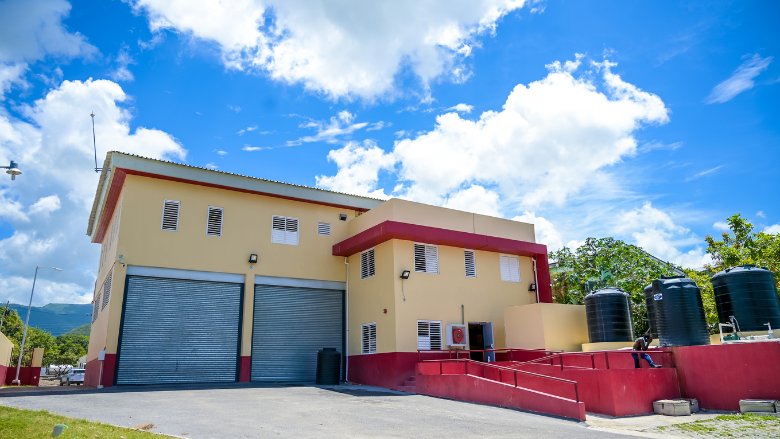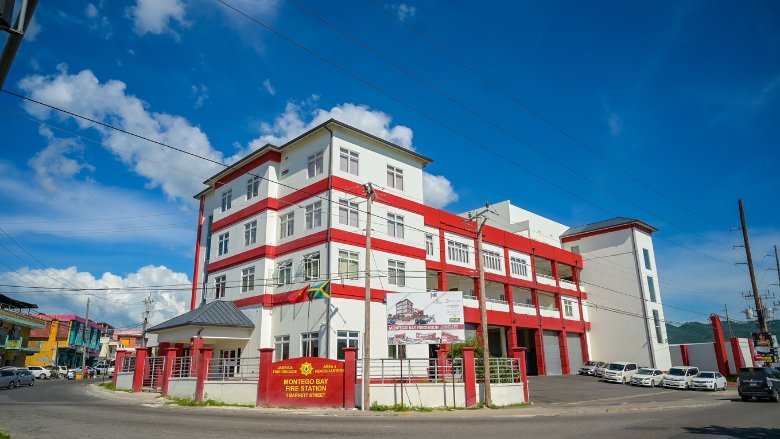Shouts of “I want to be a firefighter, I want to save people” can be heard regularly from the garage of the Montego Bay Fire Station located on Barnett Street in the town center, as children from schools in St. James and surrounding parishes visit the new four–storey building to meet the firefighters and learn about safety.
Young people aren’t the only ones who visit the station; it attracts adults and tourists alike. The real benefit, though, is to the firefighters, who before the construction of the new building a year ago, were housed at different locations.
“The community of St. James feels more secure knowing we are here. We’re the pride of Montego Bay…before the construction of this building, we had one that leaked and we had firefighters who would be travelling from all over. We now have training facilities, dormitories and new response vehicles, including an emergency services van”, Assistant Superintendent McLaren shared during a tour with a team from the World Bank.
Included in those response vehicles are two water tender trucks, which were handed over to the brigade during the signing ceremony. They each have an 8,000-liter reinforced coated steel tank, and maximum water pumping capacity of 1,000 liters per-minute. The trucks provide for easy manoeuvrability on hilly terrain and narrow roadways and come equipped with attachments and tools such as fire extinguishers, hydrant hoses and adapters, hydrant keys, and suction wrenches.
Community members in Yallahs, St. Thomas are also happy to have a new fire station. Less than a year old, the new fire station greets visitors to the community.
According to Assistant Superintendent Knox, “we serve a large area of St. Thomas and now we can respond much faster. We had challenges before including issues with the building but now it’s more comfortable and can accommodate more firefighters.”
Features of the new building include male and female dormitories, two engine bays, a kitchen, recreation room, fitness area, control room, bathrooms, rainwater harvesting system, and an emergency medical room. Combined, both fire stations will serve almost 300 firefighters.
At the ground-breaking of the Montego Bay facility in 2019, Commissioner of the Jamaica Fire Brigade, Stewart Beckford, shared his thoughts, stating that the new building and facilities would improve service (to the area) and provide a permanent home for the city’s firefighters. He added that there had been an increase in calls to the St. James division. For example, in 2006, when the facility was closed, the division responded to 821 fire calls. In comparison, in 2018 the division responded to approximately 1,700 fire calls, he said.
At the opening of the Yallahs Station, Commissioner Beckford commended the firefighters who have assisted the Brigade in executing its mandate of saving lives and protecting property in St Thomas. He further pointed out that the parish hadn’t seen any fire-related deaths in the previous five years.
Both fire stations, and an additional station in Port Maria, St. Mary are part of the Jamaica Disaster Vulnerability Reduction Project which supports the Government of Jamaica in disaster risk management in the wider context of sustainable development, resilience to disasters or hazards, and climate risk.
Previously, the Jamaica Fire Brigade (JFB) operated a network of 33 fire stations throughout the country; which had proven inadequate to provide effective fire and rescue service for the country. The Project supported the construction of three fire stations to enable the Brigade to better respond to emergencies and avert possible disasters in Port Maria, Montego Bay and Yallahs.
The objective of the Jamaica Disaster Vulnerability Reduction Project (JDVRP) is to enhance the climate and disaster resilience of key infrastructure assets and the country’s disaster response capacity. This was achieved through a mix of physical investments, technical assistance and risk financing, with the expectation of reduced devastation caused by natural hazards on the productive sectors of the economy, decreased recovery period, and elimination or reduction of the need for the Government of Jamaica to divert budgetary allocations to directly finance disaster recovery.
Hazards present a significant contingent liability for Jamaica comparable to others, such as commodity price fluctuations and exchange rate volatility. Mitigating and adapting to these hazards such that they do not become perilous disasters bodes well for the sustainability of Jamaica’s environment and economy.



